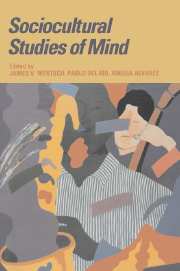Book contents
- Frontmatter
- Contents
- Series Foreword
- List of contributors
- Sociocultural studies: history, action, and mediation
- Part I Human action: historical and theoretical foundations
- Part II Mediation in action
- 4 Writing and the mind
- 5 An approach to an integrated sensorimotor system in the human central brain and a subconscious computer
- Part III Sociocultural setting, intersubjectivity, and the formation of the individual
- Part IV Sociocultural settings: design and intervention
- Index
4 - Writing and the mind
Published online by Cambridge University Press: 05 June 2012
- Frontmatter
- Contents
- Series Foreword
- List of contributors
- Sociocultural studies: history, action, and mediation
- Part I Human action: historical and theoretical foundations
- Part II Mediation in action
- 4 Writing and the mind
- 5 An approach to an integrated sensorimotor system in the human central brain and a subconscious computer
- Part III Sociocultural setting, intersubjectivity, and the formation of the individual
- Part IV Sociocultural settings: design and intervention
- Index
Summary
I take it as fundamental to the cultural psychology envisioned by Vygotsky and others that cultural, historical activities shaped and continue to shape perception, action, and, indeed, consciousness. Some would go so far as to suggest that mind is a cultural artifact, not in the sense that it does not exist, but rather that it exists in the way that laws and debts exist – namely, as cultural inventions used for managing social action and interaction. Others take mind to be real, a kind of mental organ, for which cultures provide various forms of expression. However it is to be ultimately explained, a central preoccupation of a cultural psychology is with the ways that the culture gives shape to mind – to perception, thought, and action.
And I take it as equally fundamental to that cultural psychology that the intellectual development of children be seen, at least in part, as the acquisition of symbolic and representational systems of the culture. Learning a language is the primary means of acquiring the folkways of the culture. Further, learning the various notational systems of the culture – that is, the cultural means of storing and communicating information in a variety of written and ritualized forms – plays a secondary, but nonetheless significant role.
- Type
- Chapter
- Information
- Sociocultural Studies of Mind , pp. 95 - 123Publisher: Cambridge University PressPrint publication year: 1995
- 15
- Cited by

